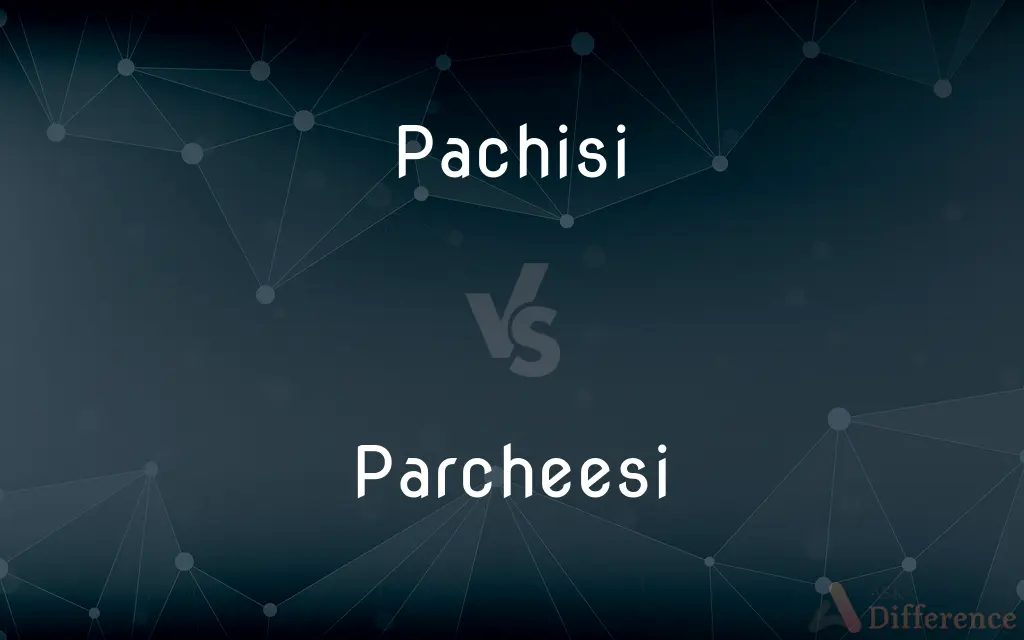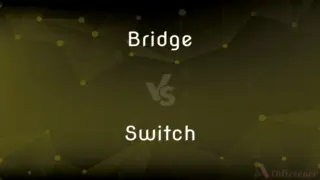Pachisi vs. Parcheesi — What's the Difference?
By Urooj Arif & Maham Liaqat — Updated on March 20, 2024
Pachisi is an ancient board game originating from India, known for strategy and chance, whereas Parcheesi is its American adaptation, featuring simplified rules and gameplay.

Difference Between Pachisi and Parcheesi
Table of Contents
ADVERTISEMENT
Key Differences
Pachisi, an ancient Indian game, is often called the "national game of India" and involves strategy and chance. On the other hand, Parcheesi, an American adaptation of Pachisi, simplifies some of the original game's rules and is played on a square board. It became popular in the United States in the late 19th century and is known for its distinctive board of bright colors and simplified gameplay.
The original Pachisi is typically played with two or four players, who strategize to capture opponents' pawns while navigating their own to safety. This requires careful planning and strategy, considering the rolls of the dice, which are traditionally six or seven cowrie shells. Whereas Parcheesi is also designed for two to four players but incorporates a single die or two dice, contributing to a game that balances strategy with the randomness of dice rolls.
Pachisi uses a board that is shaped like a cross, symbolizing the Indian concept of Mandala and is designed for play in a large outdoor area, reflecting its social and ceremonial roots in ancient India. Parcheesi's board, however, is square and designed for tabletop play, making it more accessible for indoor family entertainment in a Western context.
In Pachisi, capturing an opponent's pawn requires landing on the same space occupied by that pawn, which then sends the captured pawn back to start. This element of the game emphasizes strategy and can lead to a more competitive play style. Parcheesi retains this rule but includes safe spaces where pawns cannot be captured, adding an extra layer of strategy and safety for players.
The cultural significance of Pachisi reflects its historical roots and importance in Indian tradition, where it was played by royalty and commoners alike. Parcheesi, while maintaining the essence of its predecessor, lacks the cultural depth and historical context of Pachisi but has its own place in American board gaming history, symbolizing the adaptation and transformation of an ancient game into a modern family pastime.
ADVERTISEMENT
Comparison Chart
Origin
India
United States
Board Shape
Cross-shaped
Square
Gameplay Complexity
More complex rules, involves strategy and chance
Simplified rules, balances strategy and chance
Dice Used
Cowrie shells or traditional dice
Cubical dice
Objective
Move all pawns around the board and back home
Similar, but with some simplified rules
Cultural Significance
Deep-rooted in Indian tradition
Adaptation with a significant place in American board gaming
Player Interaction
Includes capturing opponents' pawns
Similar, with the addition of safe spaces
Historical Context
Ancient game, played by royalty and commoners
Adapted in late 19th century for American audiences
Compare with Definitions
Pachisi
To navigate all four pawns around the board and return them home.
Achieving victory in Pachisi demands both strategic prowess and favorable dice rolls.
Parcheesi
The American adaptation of Pachisi, known for its simplified rules and family-friendly gameplay.
Parcheesi became a household name in the U.S., offering a simplified version of the classic Indian game.
Pachisi
An ancient Indian board game known for its strategic play and cultural significance.
Pachisi is often celebrated in Indian festivals with large, colorful boards and real people as pawns.
Parcheesi
Combines strategy with the randomness of dice rolls, suited for family entertainment.
Parcheesi’s appeal lies in its balance of strategy and chance, making it a favorite among board game enthusiasts.
Pachisi
Involves strategy, chance, and capturing opponents' pawns.
The essence of Pachisi gameplay requires careful planning and luck with cowrie shell rolls.
Parcheesi
Became a popular American board game, representing a cultural adaptation.
Parcheesi's introduction to America marked the transformation of an ancient game into a modern pastime.
Pachisi
Traditionally a large, cross-shaped playing area.
The cross-shaped Pachisi board symbolizes the Indian Mandala, integrating the game into cultural practices.
Parcheesi
A square board with a colorful, distinctive design.
The square Parcheesi board, with its bright colors and clear markings, is designed for easy home play.
Pachisi
Deeply embedded in Indian tradition and history.
Pachisi's historical roots trace back to ancient India, reflecting its cultural importance.
Parcheesi
Similar to Pachisi but incorporates simplified rules for a broader audience.
Winning in Parcheesi still requires moving all pawns home but is made accessible with clearer rules.
Pachisi
Pachisi (, Hindustani: [pəˈtʃiːsiː]) is a cross and circle board game that originated in Ancient India. It is described in the ancient text Mahabharata under the name of "Pasha".
Parcheesi
Parcheesi is a brand-name American adaptation of the Indian cross and circle board game Pachisi, published by Parker Brothers and Winning Moves Games USA.
Pachisi
An ancient game of India similar to backgammon that is played on a board or cloth shaped like a Greek cross and that uses cowrie shells instead of dice.
Parcheesi
See Pachisi.
Pachisi
An ancient Indian board game in which players, throwing dice, shells, etc. to determine the distance of each move, attempt to be the first to take all of their counters around the board.
Parcheesi
A modern board game based on pachisi
Pachisi
A game, somewhat resembling backgammon, originating in India.
Pachisi
A game adopted from the Indian game, using disks, as of pasteboard, and dice; it is played on a cross-shaped board.
Pachisi
An ancient board game resembling backgammon; played on a cross-shaped board
Common Curiosities
What is Parcheesi?
Parcheesi is an American adaptation of Pachisi, featuring simplified rules and gameplay suited for family entertainment.
What are the main differences in gameplay between Pachisi and Parcheesi?
Pachisi involves more complex rules and traditional dice, while Parcheesi simplifies these aspects for broader appeal.
What is Pachisi?
Pachisi is an ancient Indian board game that combines strategy and chance, known for its cultural significance.
How do the objectives of Pachisi and Parcheesi compare?
Both games aim to navigate all pawns around the board and back home, but Parcheesi simplifies some rules.
Can Pachisi and Parcheesi be played by the same number of players?
Yes, both games are designed for two to four players, emphasizing strategy and player interaction.
How did Parcheesi become popular in the United States?
Parcheesi gained popularity in the late 19th century due to its accessible rules and family-friendly design.
How do the dice used in Pachisi and Parcheesi differ?
Pachisi traditionally uses cowrie shells or seeds for dice, while Parcheesi uses cubical dice.
Is the board design significant to the gameplay of Pachisi and Parcheesi?
Yes the board design significant to the gameplay of Pachisi and Parcheesi.
What makes Pachisi culturally significant in India?
Its ancient origins, historical context, and integration into cultural traditions make Pachisi significant in India.
Are there any safety spaces in Pachisi like in Parcheesi?
Pachisi’s traditional rules don't include safe spaces, a feature that Parcheesi introduced.
Share Your Discovery

Previous Comparison
Dusky vs. Husky
Next Comparison
Bridge vs. SwitchAuthor Spotlight
Written by
Urooj ArifUrooj is a skilled content writer at Ask Difference, known for her exceptional ability to simplify complex topics into engaging and informative content. With a passion for research and a flair for clear, concise writing, she consistently delivers articles that resonate with our diverse audience.
Co-written by
Maham Liaqat












































